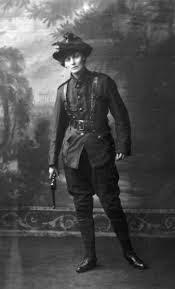By Lauren Arrington

No one ever seems to ask whether MacDonagh and MacBride, Connolly and Pearse (never mind de Valera and Collins) happened to fire shots at an unarmed individual, policeman or a. But whether Constance Markievicz shot an unarmed constable at St Stephen’s Green is the question on which the public judgment of her character hangs.
By the afternoon of the first day of the Rising, six policemen had been shot, two fatally, and at least two of them were unarmed. The young Abbey actor Seán Connolly—who was the first among the rebels to die, and whose last moments have been recounted by witnesses and historians in tragic detail—shot an unarmed constable who stood guard at Dublin Castle. The righteousness of this act seems to be unquestionable. Yet, partly because she had the audacity to survive the Rising and its aftermath, Markievicz’s identical sin has plagued the public imagination.
One witness, district nurse Geraldine Fitzgerald, recorded in her diary that as she was returning from duty to the nurse’s home, located at the southwest corner of the Green, she saw:
“A lady in a green uniform, the same as the men were wearing (breeches, slouch hat with green feathers etc.) the feathers were the only feminine feature in her appearance, holding a revolver in one hand and a cigarette in the other, was standing on the footpath giving orders to the men. We recognized her as the Countess de Markievicz – such a specimen of womanhood. There were other women, similarly attired, inside the Park, walking about and bringing drinks of water to the men. We had only been looking out a few minutes when we saw a policeman walking down the path from Harcourt Street. He had only gone a short way when we heard a shot and then saw him fall forward on his face. The Countess ran triumphantly into the Green saying “I got him” and some of the rebels shook her by the hand and seemed to congratulate her.”
Fitzgerald gives details of Constable Lahiff’s wounds: he had been “shot in the lung, close to the heart and was bleeding profusely. A doctor arrived at the same time as we [the nurses] did”. Lahiff was sent to hospital, where he died half an hour after admission. The death certificate attributed the cause to “a bullet through both lungs and left arm”.
Max Caulfield and subsequent historians of the Rising have reported that Lahiff was shot three times in the head. Such circulation of factual errors exacerbates the confusion surrounding the event. Markievicz’s later insistence that she did not shoot a policeman further obscures the truth.
Seven months after the Rising, in November 1916, Constance told her sister, Eva, “how she held a revolver at a policeman’s chest but could not shoot when it came to the point” because “she recognized him & had known him before”. However, this was just one policeman among many; she also recalled that she may have “hit one in the arm as he jumped”. This was probably Lahiff. It appears that Markievicz understood “shot” to mean “killed”. Since Lahiff did not die at the scene, Markievicz had no way of knowing that what appeared to be a wound to the arm had been fatal.
The facts of the incident and a rational explanation of Markievicz’s denial of the shooting may do little to influence public opinion, which continues to be governed by emotive and fallacious accounts. If Markievicz’s death sentence had been carried out, would historians or the general public view her actions with more sympathy? Possibly. But probably not. Her execution would not have affected the account offered by W. E. Wylie of her Court Martial, which holds so much sway. Nor would it have stymied O’Casey’s vitriol or changed Yeats’s verdicts. A clue to the reason lies in nurse Fitzgerald’s diary: “the Countess de Markievicz – such a specimen of womanhood.”
Lauren Arrington is Senior Lecturer at the Institute of Irish Studies, University of Liverpool. She is the author of Revolutionary Lives: Constance and Casimir Markievicz, published this month by Princeton University Press.
Great article, thanks. I signed up to your blog rss feed.